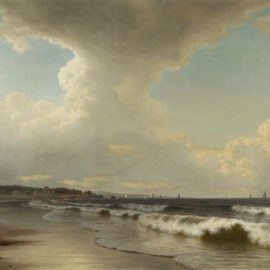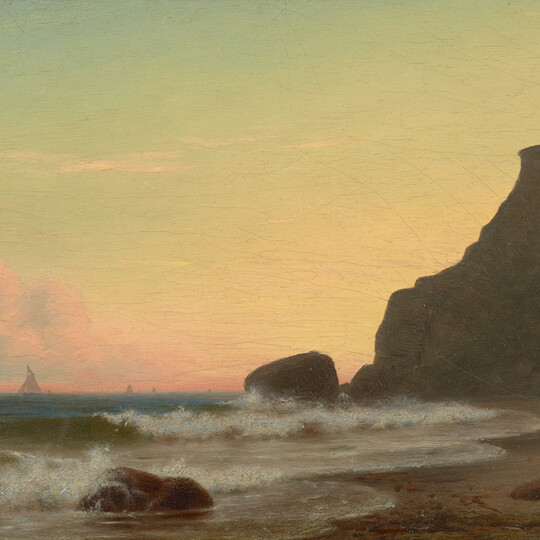Artist Biography
William Frederick de Haas’s coastal scenes put forward a pictorial language of serenity, silence, and solitude. Born in Holland, de Haas studied at The Hague and moved to the United States at the age of twenty-four. Armed with the precepts of Dutch painting, he turned his attention to the American coast. He worked in New York’s Tenth Street Studio Building alongside his brother Mauritz, his fellow Dutchman Kruseman Van Elten, and the leading artists of the Hudson River School, and became one of the nineteenth century’s few marine specialists. His expansive scenes of Maine, Long Island, and Newfoundland provide an
William Frederick de Haas’s coastal scenes put forward a pictorial language of serenity, silence, and solitude. Born in Holland, de Haas studied at The Hague and moved to the United States at the age of twenty-four. Armed with the precepts of Dutch painting, he turned his attention to the American coast. He worked in New York’s Tenth Street Studio Building alongside his brother Mauritz, his fellow Dutchman Kruseman Van Elten, and the leading artists of the Hudson River School, and became one of the nineteenth century’s few marine specialists. His expansive scenes of Maine, Long Island, and Newfoundland provide an important bridge between the Dutch tradition and the Luminist movement then emerging in American art.
De Haas’s seascapes combine the transcendental light of Luminism with the timeless tranquility of the Dutch Golden Age. Seventeenth-century Dutch art served as an important precedent for the American Luminists; the straight horizons, open-ended compositions, and direct observation that fueled Dutch landscapes laid the foundation for Luminist design. In turn, the Luminists modified the Dutch mode to fit a more classical paradigm of geometric structure and balance. De Haas’s painting occupies an intermediate space in the evolution of Luminism, maintaining Dutch principles while embracing American order. His work demonstrates that Luminism itself was timeless in nature, appropriating historical traditions in the service of transcendental vision.
De Haas exhibited regularly at the National Academy of Design and the Brooklyn Art Association between 1867 and 1880. Today his work is in the Akron Art Museum in Ohio, as well as the collections of the Cortland Free Library and Wells College in New York.
William Frederick de Haas’s coastal scenes put forward a pictorial language of serenity, silence, and solitude. Born in Holland, de Haas studied at The Hague and moved to the United States at the age of twenty-four. Armed with the precepts of Dutch painting, he turned his attention to the American coast. He worked in New York’s Tenth Street Studio Building alongside his brother Mauritz, his fellow Dutchman Kruseman Van Elten, and the leading artists of the Hudson River School, and became one of the nineteenth century’s few marine specialists. His expansive scenes of Maine, Long Island, and Newfoundland provide an important bridge between the Dutch tradition and the Luminist movement then emerging in American art.
De Haas’s seascapes combine the transcendental light of Luminism with the timeless tranquility of the Dutch Golden Age. Seventeenth-century Dutch art served as an important precedent for the American Luminists; the straight horizons, open-ended compositions, and direct observation that fueled Dutch landscapes laid the foundation for Luminist design. In turn, the Luminists modified the Dutch mode to fit a more classical paradigm of geometric structure and balance. De Haas’s painting occupies an intermediate space in the evolution of Luminism, maintaining Dutch principles while embracing American order. His work demonstrates that Luminism itself was timeless in nature, appropriating historical traditions in the service of transcendental vision.
De Haas exhibited regularly at the National Academy of Design and the Brooklyn Art Association between 1867 and 1880. Today his work is in the Akron Art Museum in Ohio, as well as the collections of the Cortland Free Library and Wells College in New York.


